In the last campaign, Watford were performing nicely, getting 50 points in the Premier League, ranked at 11th. In the FA Cup, they beat Wolves to enter the final, although they lost that game to Manchester City. In the summer, they upgraded their squad with a record-breaking signing, Ismaïla Sarr, hence why everyone expected the team to be getting even better than the last campaign.
It turned out to be quite the contrary though, and it had been a difficult season for Watford. After being unable to secure a single win in August, Javi Gracia was subsequently sacked. Their former manager Quique Sánchez Flores returned, but he only obtained 0.83 points on average in 12 games. As a result, Watford welcomed a new manager again, Nigel Pearson.
The 56-year-old manager’s Watford showed tremendous improvement as they were no longer the bottom team of the league. After 24 games, they had 23 points and stayed 19th in the table because of the goal difference.
In this head coach tactical analysis, we will show you the playing style and improvements of Watford under Pearson. It is an analysis that focuses on Pearson’s philosophy and tactics.
Watford’s attacking style of play
Under different managers, Watford had been trying different formations and under Pearson, the players performed quite well under a 4-2-3-1 system. For the first phase of their attack, they did not insist on playing out from the back, as it is reflected below in the weak passing links between Craig Dawson, Craig Cathcart, and Nathaniel Chalobah.
Their top passing links occurred between their attacking players, with Abdoulaye Doucouré connecting Gerard Deulofeu and Sarr. These players are pivotal to the attack as they have improved recently, which is also a topic we will explain.
Another point to note is Troy Deeney, whose average position nearly overlapped with Doucouré in the game against Bournemouth. The skipper utilised his aerial dominance and Watford played directly.
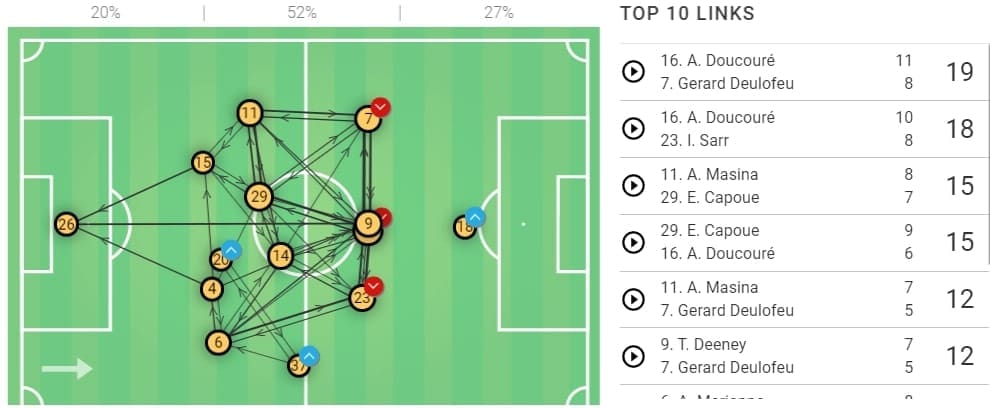
Aerial dominance of Deeney
Watford missed Deeney after the forward underwent knee surgery. They tried to play Danny Welbeck up front, but the physicality of the former Arsenal man was nowhere near that of Deeney’s. In the loss against Wolves, Welbeck only won two of his seven aerial duels and four of his 12 ground duels. This meant the team found it difficult to progress the ball to the final third.
The return of Deeney was important as the skipper dominated the ball in the air and so he was the target man of Ben Forster’s or the defenders’ long balls. In the game against Tottenham and Manchester United, the aerial successful rate of Deeney was 62% and 65% respectively, in 29 and 17 aerial duels.
Usually, Deeney dropped from the frontline and fought for the ball around the midfielders. Meanwhile, his teammates would be making runs around the 31-year-old forward to receive his layoffs. The aerial dominance of Deeney became an important outlet for Watford to enter the final third.
In the following example, in a goal kick against United, Deeney dropped, got rid of Victor Lindelöf, and then headed the ball without pressure to Doucouré. Deulofeu ran centrally to force Aaron Wan-Bissaka to come inside while Sarr was making a forward run between Harry Maguire and Luke Shaw. These movements generated spaces for Doucouré to exploit on the left flank. This attack, eventually, turned into a shot inside the box.
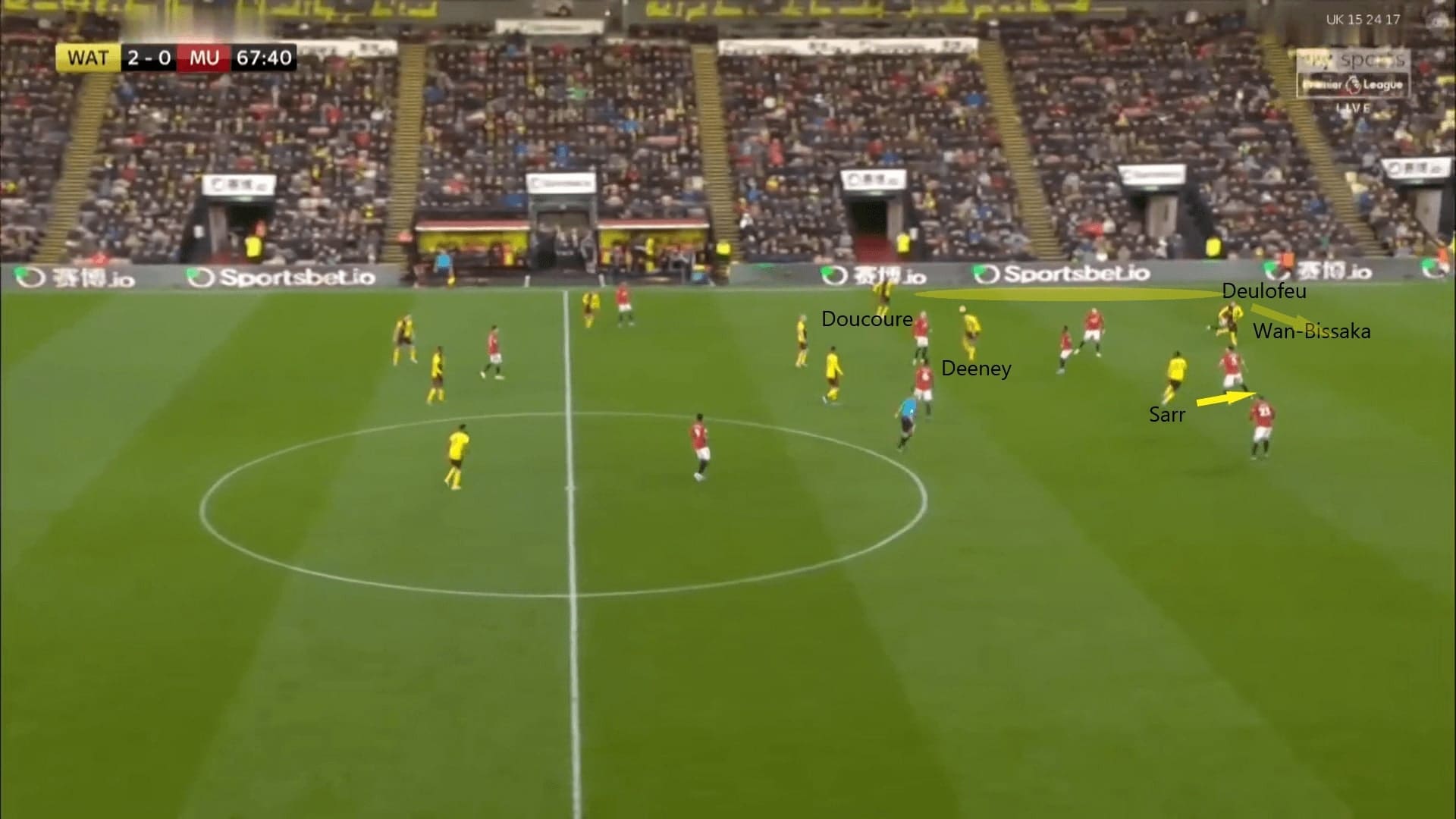
Doucouré as an attacking midfielder
Under Gracia and Sánchez Flores, Doucouré was playing as a defensive midfielder or central midfielder, staying in a relatively deeper position. By contrast, Pearson noticed the attacking ability of the Frenchman, and so Doucouré was now used as an attacking midfielder under the new manager. He contributed a lot on both ends.
The below graph is the forward passes map of Doucouré in the match against Wolves. We could observe the pattern and the direction of his forward passes, most of which were diagonal passes to the flanks. When considering the passing link as shown in the previous section, this is proof that Doucouré was passing the ball the wingers.
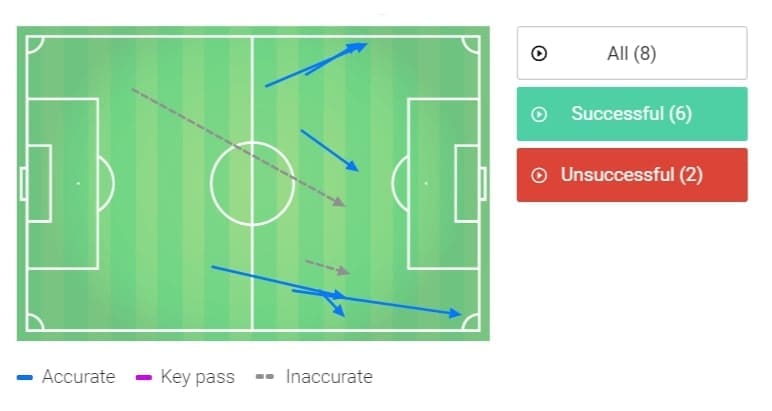
Below is an example of Doucouré releasing the wide players, as it was one of his most important functions in the final third. When Deulofeu came inside, it opened the wide corridor for the left-back, Kiko Femenía. Since Doucouré took Leander Dendoncker out of position, this generated spaces for Femenía to run behind. It was one of his diagonal passes to find the wide player, which was another method for Watford to enter the final third apart from the aerial presence of Deeney. The Frenchman also grabbed two goals and an assist with his runs to the box. He is vital to Watford’s attack.
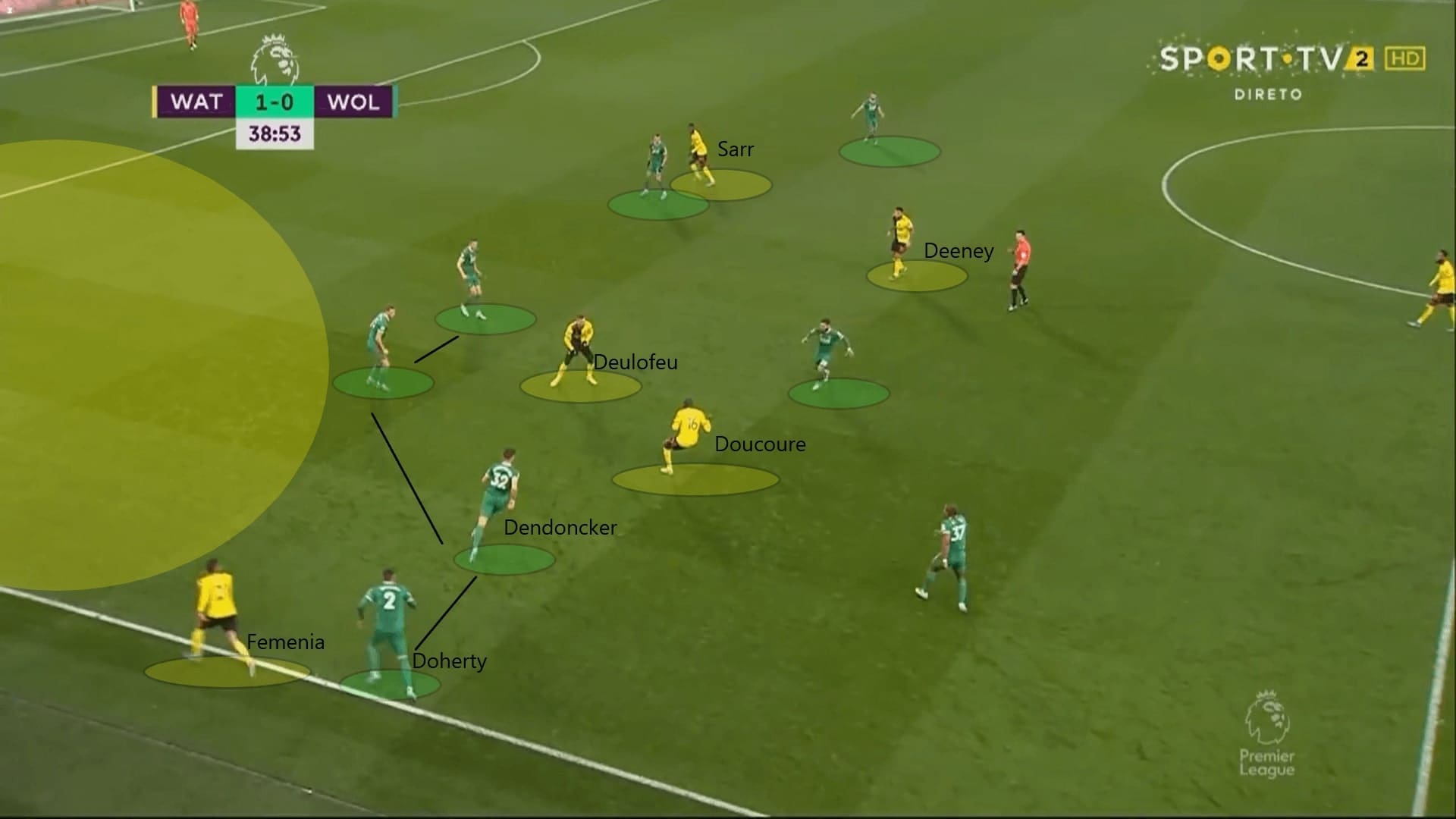
On the other hand, defensively, Doucouré was also pivotal to Watford. His relentless runs covered many balls for the team. In several games, more than half of his recoveries were made in the opposition half. In the draw against Tottenham, all seven of his recoveries were made between zone 11 and 14.
The recoveries were twofold. First, he won the ball in some counter-press situations, this tactic will be explained in the coming section. Second, he picked a lot of second balls around Deeney, which further strengthened Watford’s direct plays.
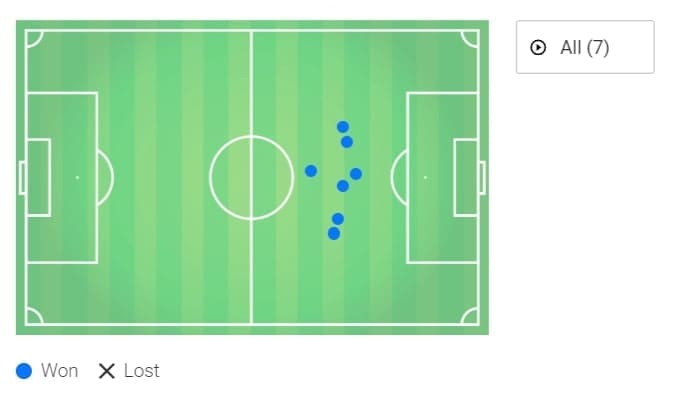
This is an example from the Tottenham game. When Toby Alderweireld cleared Adam Masina’s cross, Doucouré was the player to pick the ball before Christian Eriksen arrived. It turned to another wave of Watford’s attack, when the Frenchman won the ball high up on the pitch, as we could see Roberto Pereyra and Deeney were positioned centrally in front of the Frenchman.
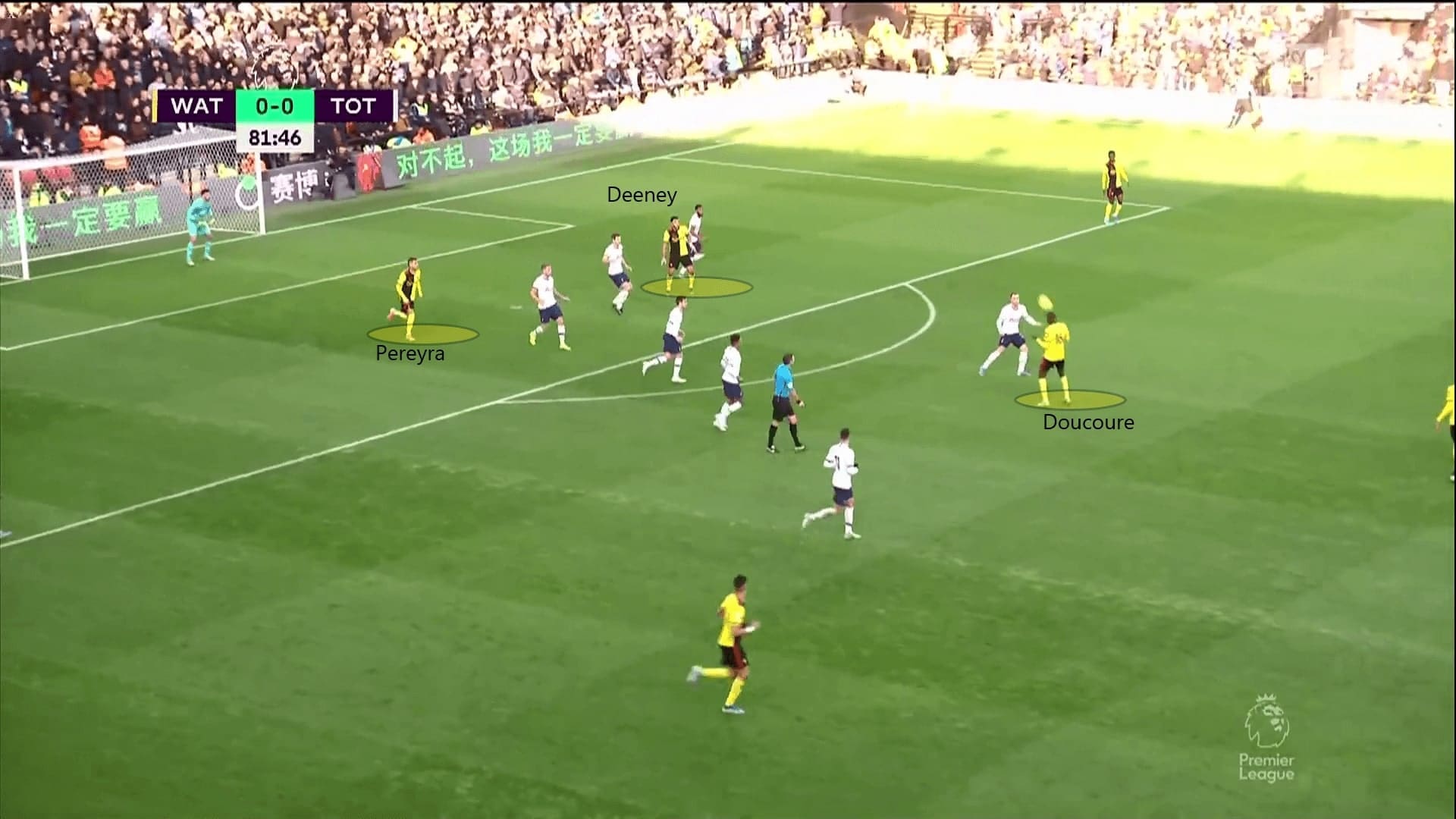
The improvement shown by Sarr
Another improved player was Sarr, who had not fully adapted to the team in the early stages of the season as he was bound by language barriers. The recent improvement of Sarr is reflected in statistics. He made two goals and assists under Pearson, becoming the explosive force who took on oppositions in the big games. He completed 50% and 45% of his dribbling against Tottenham and United, out of 10 and 11 dribbles. Given an average of 3.71 progressive runs per game, he made six and seven progressive runs in the game against Tottenham and Bournemouth.
Sarr has shown better chemistry with the right-back, who recently has been Adrian Mariappa, especially when it comes to using his body to protect the ball better. For example, on this occasion when Matt Targett came behind him, he separated the ball and the defender with his body, returning the ball to the right-back. Then, he quickly recognised the spaces generated behind the opposition left-back, turned instantaneously and exploited those spaces. Mariappa released Sarr, who provided a cross for Doucouré that nearly led to a goal.
On offensive transitions, Watford players showed passion to run forward, Sarr being one of them as well as Deulofeu. With more room to play, they hit the opposition on the counter, sealed all three points against Aston Villa, even though they were playing with 10-men. He also controlled the long ball or switch plays from the opposite flank more comfortably, allowing Watford to switch their attacking focus in an instant.
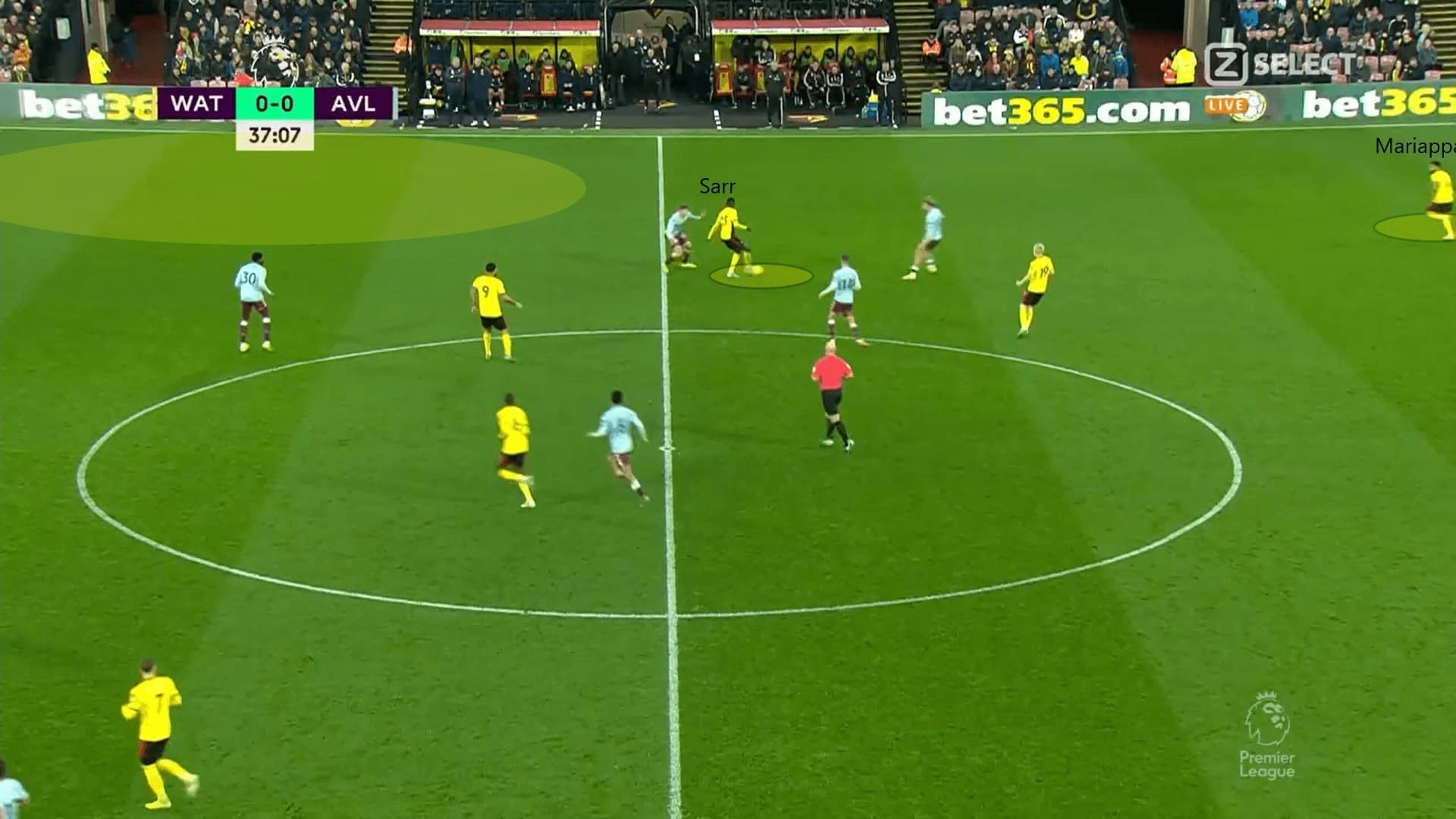
Counter-press in defensive transitions
Apart from the attack, Watford also improved defensively. On some occasions, they counter-pressed the ball once they lost it. This was because of their exposed defensive line that they found it difficult to deal with the transitions, without the concerted efforts of other players.
Their counter-press was demonstrated in the following example against Villa. Watford played long, and Kortney Hause headed to his partner, Ezri Konsa. Their front players knew their job: Deeney immediately was to counter-press the ball, with Doucouré covering the shadow. Deulofeu also stepped forward to close off Ahmed Elmohamady. Douglas Luiz was not a free player here, as Will Hughes (not in the image) was behind him. Therefore, Villa could not pass the ball comfortably to start an offensive transition. Their right-back, Elmohamady, was forced to play long which was won by Christian Kabasele in the end.
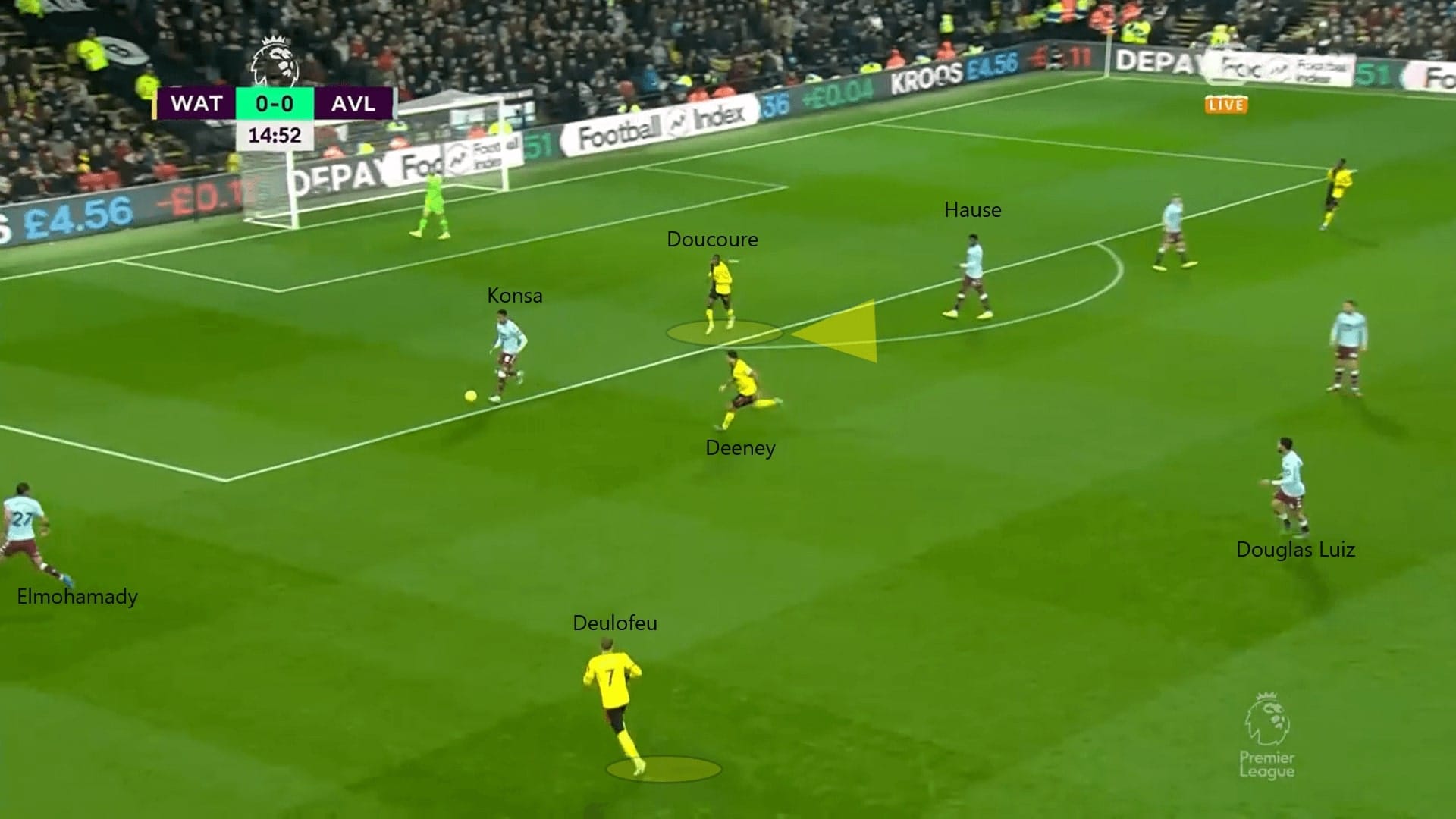
High pressing
Even in the games against stronger opponents, like Tottenham and United, Watford also played with a high press to disrupt the build-up. They pressed on the ball side, with the winger on the far side positioning himself in a more central position. They allowed the opposition to pass, as it could fall into the pressing trap set by Watford. With this approach, they turned defence into an attack and scored a goal against Bournemouth. They also created several shooting chances thanks to their high press.
Usually it was down to Deeney or Deulofeu to lead the press, while the others were staying on the ball side to look for chances to retrieve the ball.
In the win against United, the away team were heavily disrupted by the press of Watford. The positions of players are demonstrated in the following image which shows how they achieved numerical equality in United’s half. Scott McTominay was covered by Hughes, Femenía was on Daniel James, Deeney was pressing Lindelöf while Sarr was around Fred on the far side.
A pass to James was the press, as Femenía anticipated the pass and maintained a short distance with the Welshman, which was how Watford won the ball high up on the pitch and now turned into a Watford counterattack. On this occasion, Wan-Bissaka blocked Deulofeu’s cross.
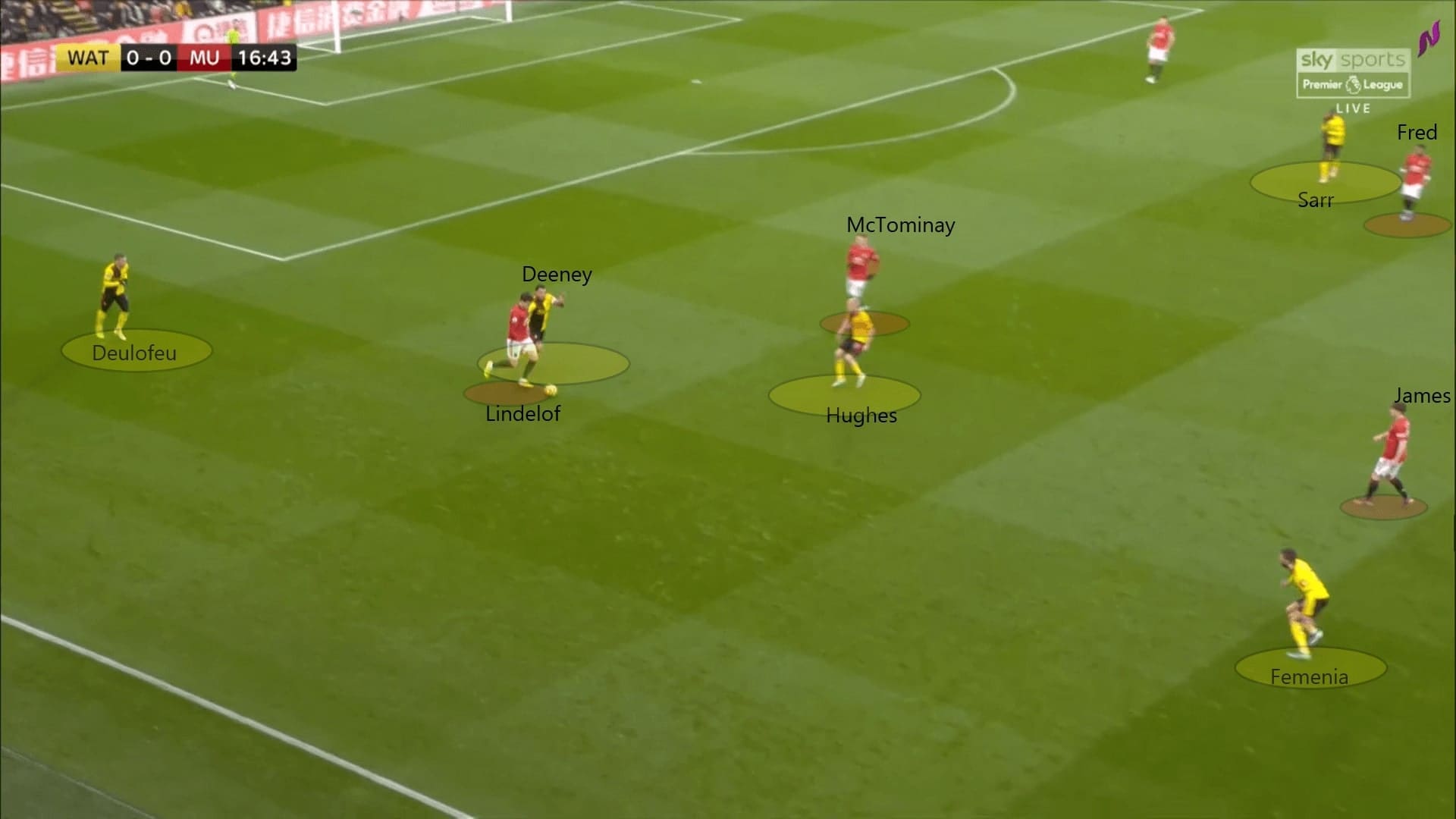
The high press of Watford required the concerted efforts of all yellow shirts on the pitch since the opponents could sometimes pick the free player. When this happened, the defensive midfielders or centre-backs of Watford would step out to pressure the ball. They had to delay the attack and form the midblock which we are going to explain in the coming section.
As James picked the ball from Wan-Bissaka, it was a pass that eliminated four Watford players. Given the huge space at the centre, under no circumstances should Watford allow James to exploit this space. Therefore, their pivot, Étienne Capoue, stepped out to provide instant pressure on James through a tactical foul that delayed the attack.
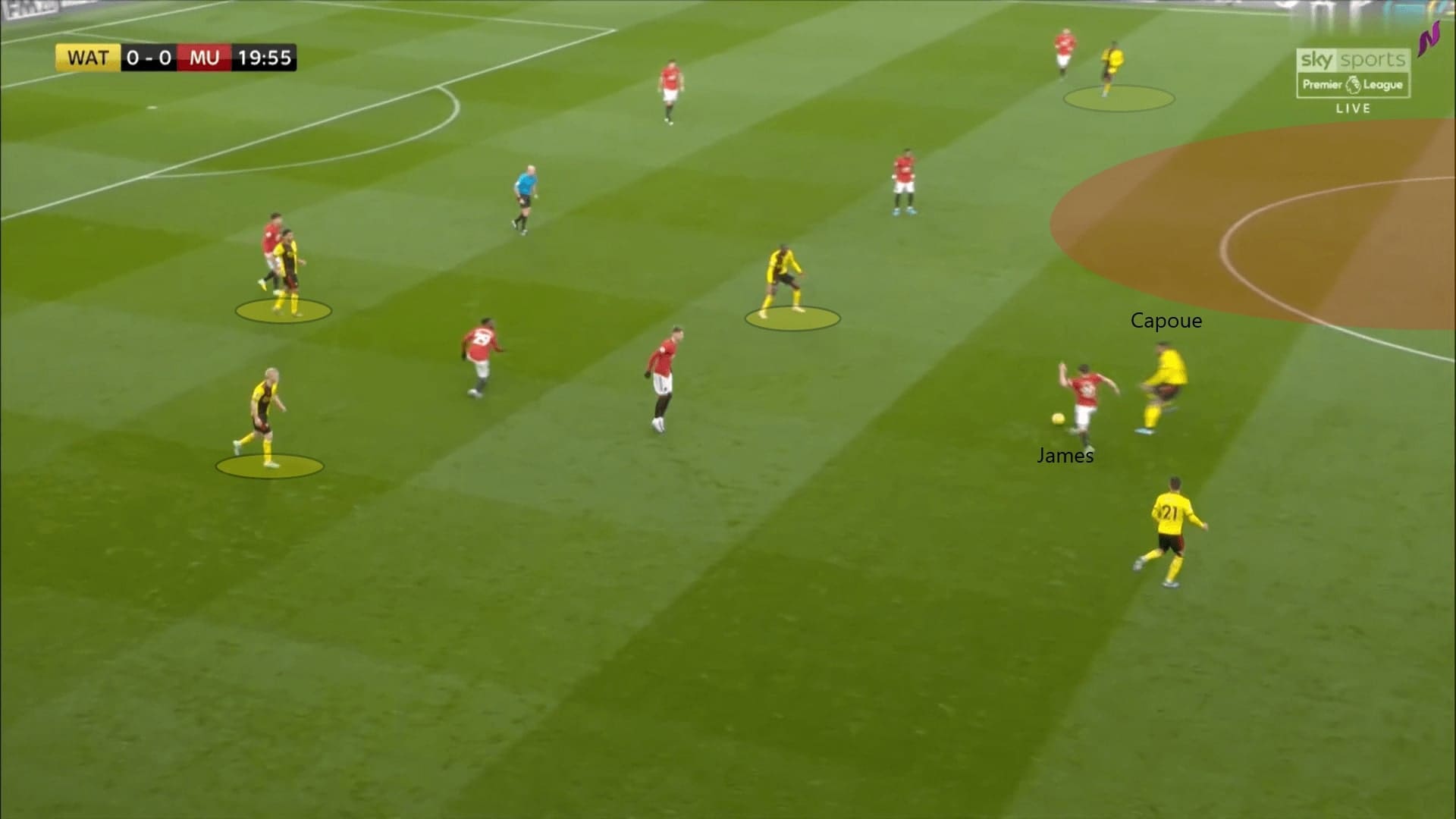
With the high press, Watford managed to win the ball high up on the pitch and converted some of them into goals. This was how they scored the opening goal against Villa and Bournemouth.
Low block
Watford defended with a low block in a 4-4-2 shape for most occasions. Sarr and Deulofeu both fulfilled their defensive duties in tracking runs. For example, the former Everton man showed huge effort to defend Adama Traoré. Since Watford tried to keep their backline compact, when the right-back stayed narrow, Sarr defended deep to cover the wide areas.
A point worth mentioning is the positioning of the pivots. Usually, they stayed close in front of the centre-backs, reducing spaces between the lines. The shape of these four players was like a box-shape, it contained and eliminated the players within the box as an option to pass. When the defenders were defending deeper in the six-yard box, the pivots also retreated deeper to cover the edge of the area or the crosses.
Their low block was demonstrated in the following example. United’s Anthony Martial was on the ball but he could not find Jesse Lingard who was making a forward run with his weaker foot. Then Hughes closed the Frenchman off while trying to cover the shadow so Martial could only pass laterally to Marcus Rashford. The box also reduced space and denied James from receiving the ball.
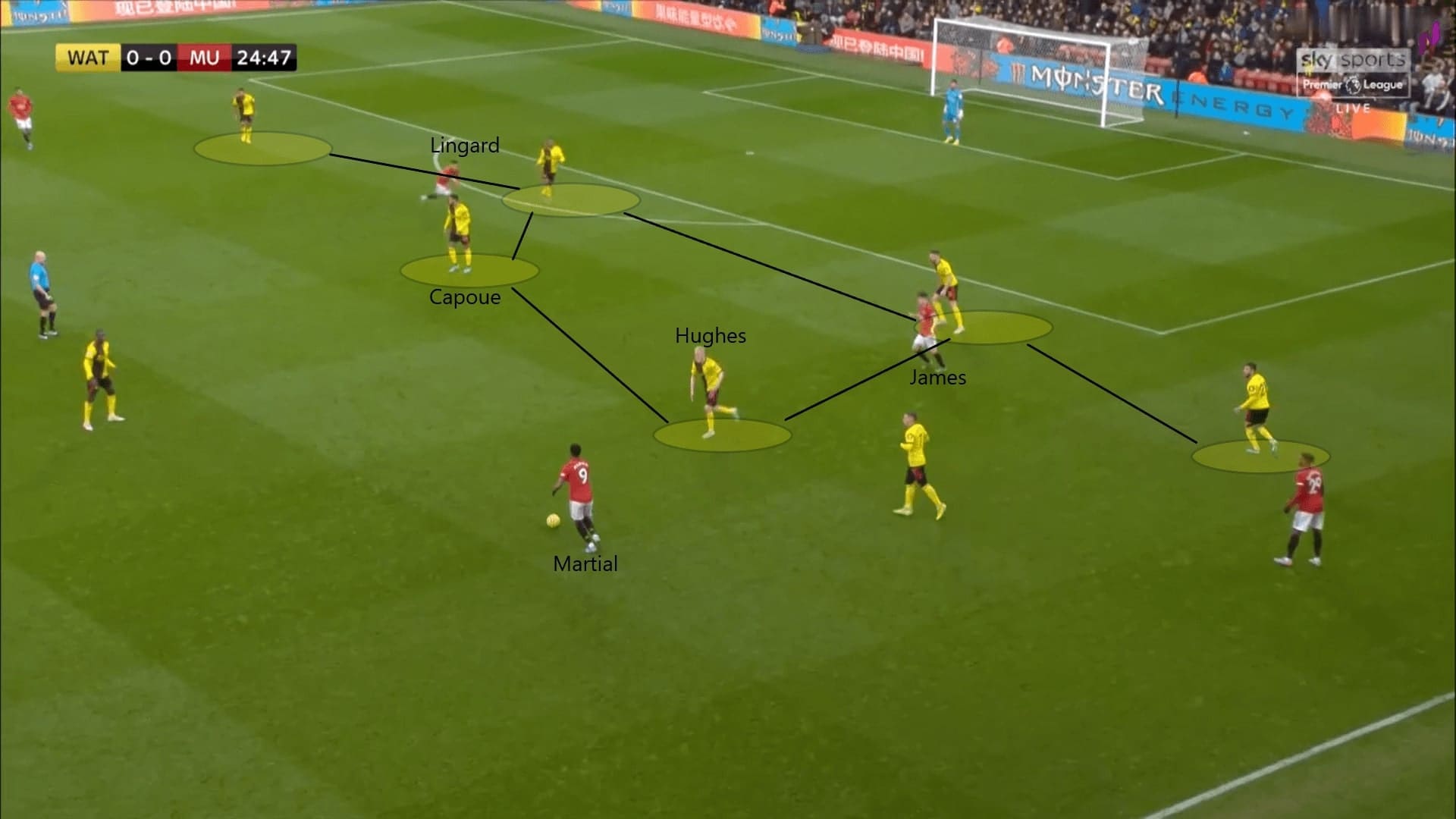
An important element of Watford’s defence was their instant pressure on the ball, regardless if it was a high press or a low block. They had to press the ball when the opposition came close to the attacking third as, under pressure, the receiver would return the pass on most occasions. Then Watford could regroup their defence again.
In the following example, Lingard thought he got some space to exploit and receive the ball as he called for a pass. However, Mariappa was right behind him, providing instant pressure on Lingard. Lingard knew the defender was behind him, therefore, he immediately returned the ball to McTominay, resulting in Watford successfully keeping the ball away from the box.
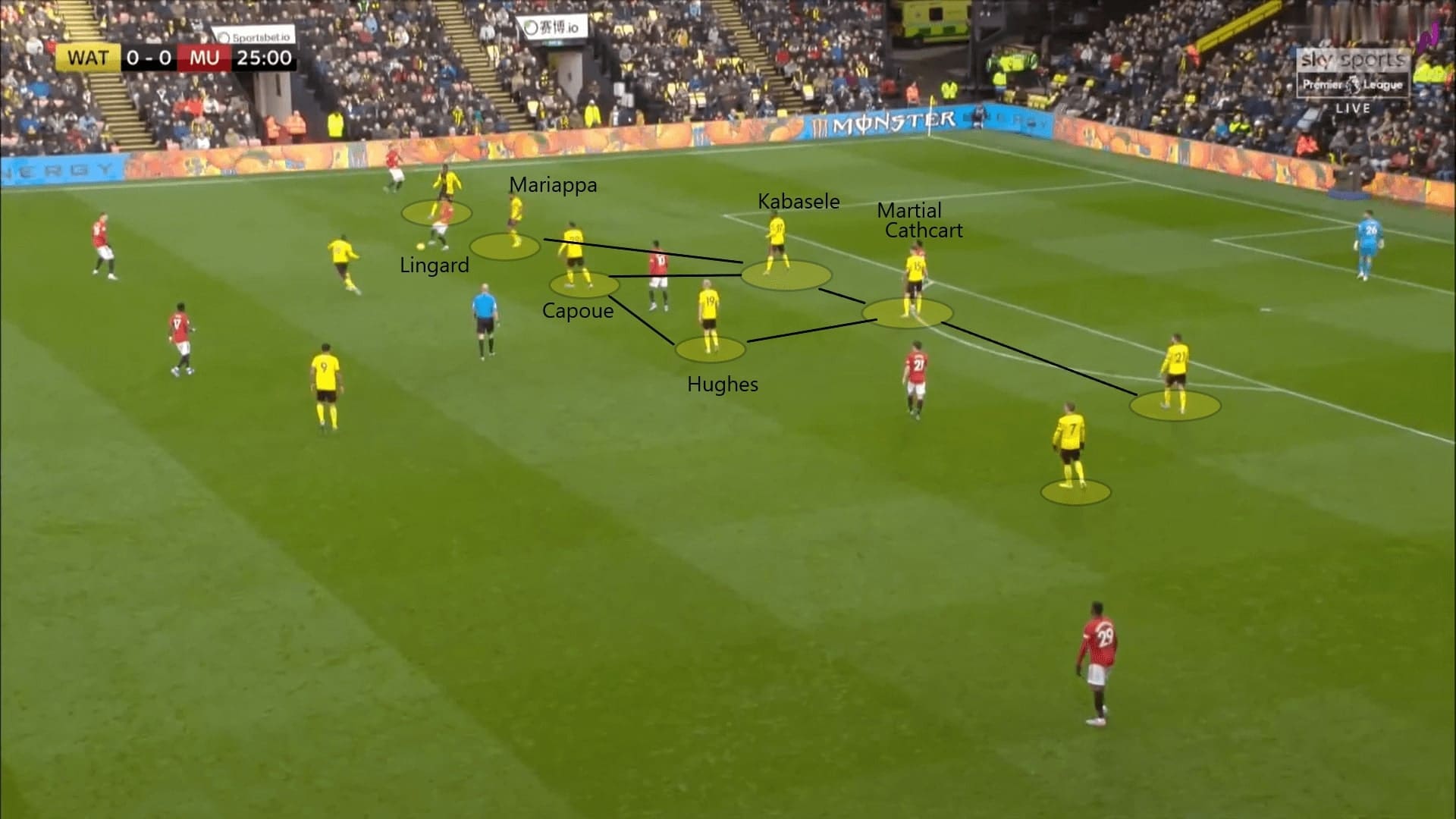
Apart from the system, Kabasele as a centre-back obtained notable statistics under Pearson’s charge. Against Sheffield United, he dealt with the long balls well, recovered the ball for 25 times and the figure was 16 against Villa. He also provided seven and six clearances against Villa and Sheffield.
When comparing the success rate of defensive duels, Dawson’s and Kabasele’s 74.65% and 72.64% ranked fifth and sixth in the league. The Belgian played a huge part in the defence.
Offside trap
On many occasions, Watford played with an offside trap. When pressing high, they pushed their defensive line forward, leaving spaces behind the defenders. Therefore, they need to play an offside trap to prevent the opposition from running behind the defenders easily.
When they were defending deeper, they also tried to play an offside trap when possible, in order to keep their opponents out of the box. As can be seen in the below example from the match against Sheffield United, they played an offside trap. When George Baldock returned the ball to John Lundstram, Watford players pushed their defensive line up to play an offside trap.
As a result, the overlapping centre-back, Chris Basham was caught offside here, meaning Watford eliminated the attack of Sheffield. Another player who stayed in an offside position was David McGoldrick, so Watford denied all two options in the box.
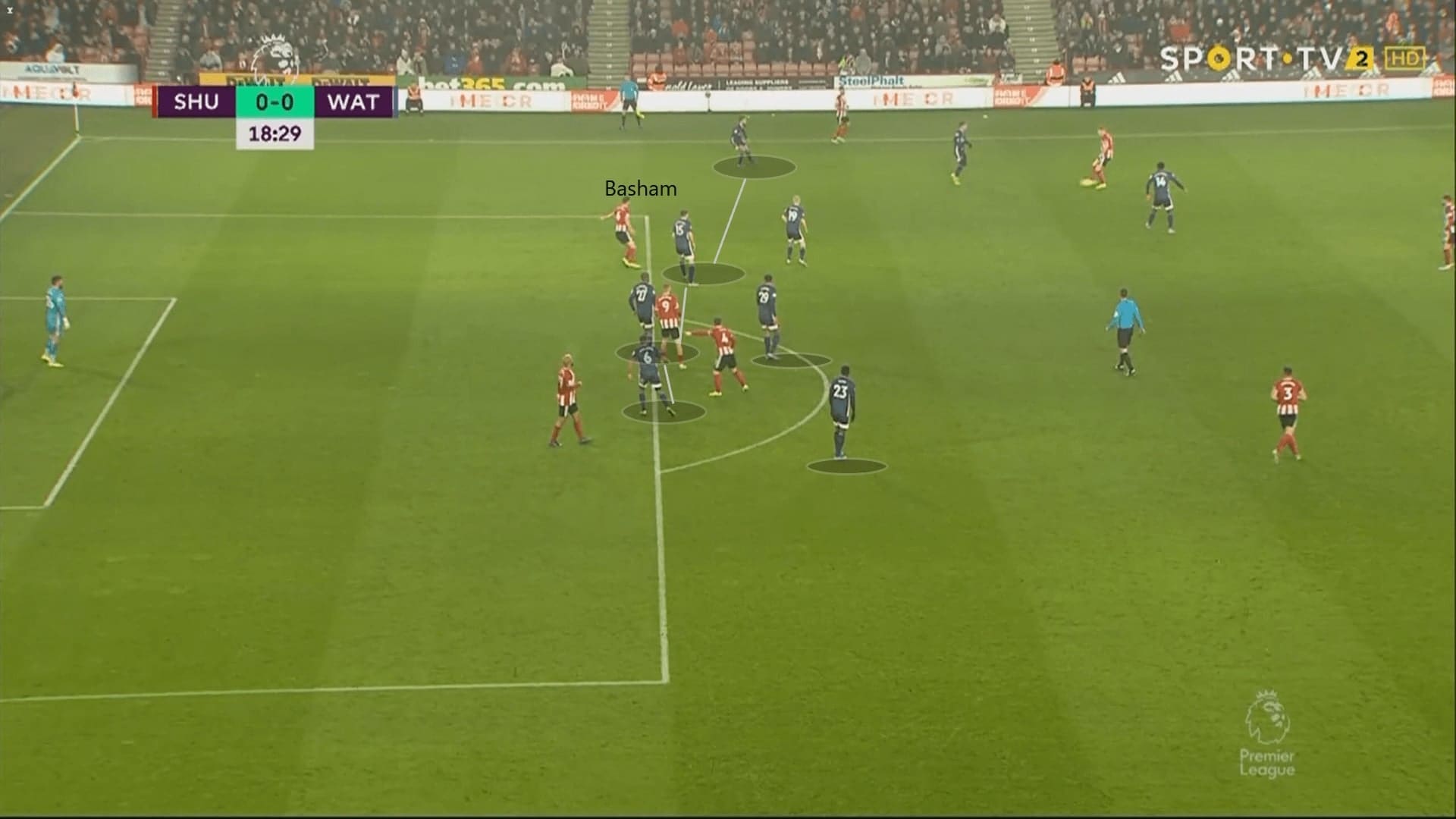
Offensive throw-ins
Watford also attacked directly with their throw-ins. Again, they utilised the physical superiority of Deeney when they got a throw-in on the right side of the attacking third. It could be illustrated in the following example from the Wolves game.
Dawson was the thrower as Deeney stayed forward to push the defence deep. He then accelerated to the ball side to receive the throw-in while Deulofeu and Sarr were lurking around the skipper. The rest of the midfielders stayed at the edge of the box to pick the second balls. On this occasion, which Deeney headed the ball from the throw-in, he found Deulofeu. The Spaniard tried a shot with the setup of attacking throw-ins.

Exposed defensive line
A question of Watford’s defence can be raised regarding the judgement of players when defending transitions. When Watford pushed the defensive line high, they left their defence exposed. Pearson’s team has had two red cards so far, one from Kabasele and the other was from Mariappa. Interestingly, both red cards occurred when Watford were defending transitions – they had to keep working on their offside trap to ease their exposed defensive line.
When the ball was played directly, or getting behind of the defenders, Watford’s defence was in trouble. For example, Kabasele misjudged the ball and got himself sent off against Wolves. Or, as demonstrated in this example, when Paul Pogba played long, Rashford ran between Femenía and Cathcart, which was the relatively weaker side. Watford defenders focused too much on the ball and lost track of Rashford, who managed to receive the ball behind the defenders, though his first touch let him down. However, the red card events and similar situations were a domain that Pearson’s team was going to work on in the future.
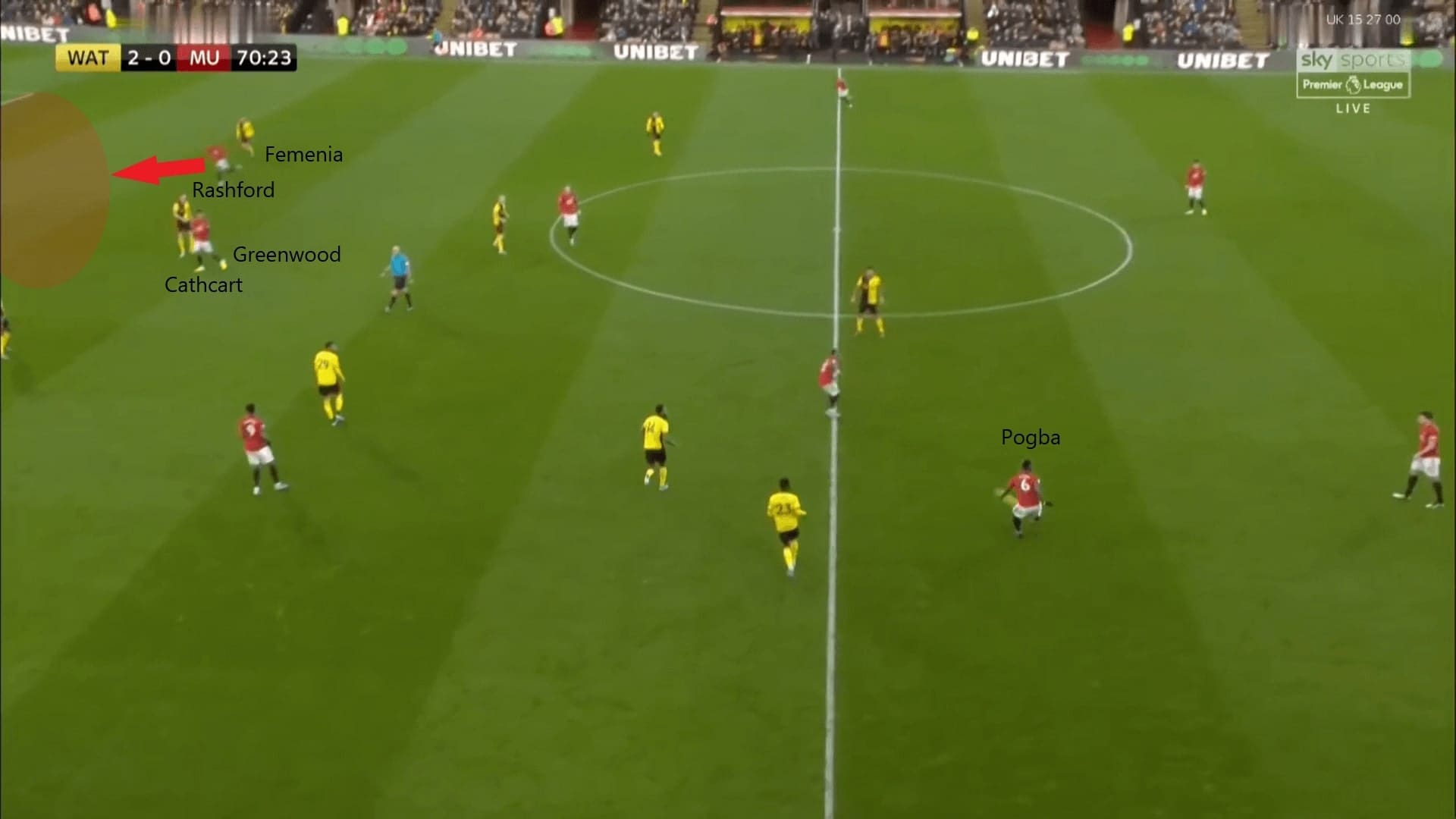
Conclusion
Watford were having hope to stay in the Premier League but their performance improved under Pearson. Their players showed incentives to press, stayed focused to defend with a deep block. These contributed to their significant victories against Villa, Wolves, and Bournemouth as they earned nine points from these matches.
However, in the most recent game against Villa, they lost. The two goals that Watford conceded could be explained by the sluggish defending of defensive midfielders, as they did not protect the centre-backs enough which allowed the free players to shoot. To briefly summarise, Watford have enough qualities and good tactics to play against other teams, all they need is to execute the tactics well and keep going.





Comments